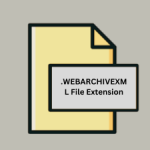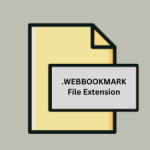.WML File Extension

What is an WML file?
WML, or Wireless Markup Language, is a markup language used for designing pages and applications for mobile devices. It was developed as part of the Wireless Application Protocol (WAP) to allow content to be displayed on early mobile phones and other wireless devices with limited processing power and display capabilities.
More Information.
WML was designed to provide a way for mobile devices to access content on the web before the widespread adoption of modern smartphones and mobile browsers. The language was optimized for the constraints of early mobile networks (such as WAP 1.x) and devices, enabling users to browse the web and interact with applications over wireless networks.
Origin Of This File.
WML was developed by the WAP Forum, which is now known as the Open Mobile Alliance (OMA). It was introduced in 1999 as a lightweight alternative to HTML, tailored for mobile devices with small screens and limited bandwidth.
File Structure Technical Specification.
- File Extension: .wml
- MIME Type: text/vnd.wap.wml
- Syntax: WML is similar to HTML but simplified. It uses a structure based on XML, with a hierarchy of elements and tags.
How to Convert the File?
Windows
- Manual Conversion:
- Open the WML file in a text editor like Notepad++ or Visual Studio Code.
- Rewrite the WML content using HTML or XHTML syntax.
- Save the new file with an
.htmlor.xhtmlextension.
- Automated Conversion:
- Use a conversion tool or script. Some scripts and programs are available online that can automate the conversion from WML to HTML.
- Examples include online conversion tools or custom scripts written in languages like Python.
Linux
- Manual Conversion:
- Open the WML file in a text editor like Vim, Nano, or Gedit.
- Convert the WML content to HTML or XHTML manually by rewriting the markup.
- Save the file with the appropriate extension.
- Automated Conversion:
- Use command-line tools or scripts for batch conversion. Python or Perl scripts can be useful for this task.
- You might find or create a script that converts WML to HTML, depending on your needs.
macOS
- Manual Conversion:
- Open the WML file with a text editor such as TextEdit, Sublime Text, or Visual Studio Code.
- Manually convert the WML content to HTML or XHTML format.
- Save the file with the new extension.
- Automated Conversion:
- Use conversion tools or scripts that support macOS. Look for tools or scripts compatible with macOS for automating the conversion process.
Android
- Manual Conversion:
- Use a text editor app like QuickEdit or Jota+ to open the WML file.
- Manually rewrite the WML content in HTML or XHTML format.
- Save the file with the new extension.
- Automated Conversion:
- Find and use conversion apps or online services accessible from your Android device. There may be online converters that you can use directly from the browser.
iOS
- Manual Conversion:
- Open the WML file in a text editor like Textastic or Koder.
- Manually convert the WML content to HTML or XHTML.
- Save the file with the new extension.
- Automated Conversion:
- Use online conversion services through Safari or other browsers on your iOS device. Look for web-based tools that can handle WML to HTML conversion.
Others
- Manual Conversion:
- Use a text editor available on your system to open the WML file.
- Rewrite the WML content using HTML or XHTML syntax.
- Save the converted file with the appropriate extension.
- Automated Conversion:
- Search for online conversion tools or software that supports WML to HTML conversion. This method can be used across various platforms as long as you have internet access.
Advantages And Disadvantages.
Advantages:
- Optimized for Mobile Devices: Designed specifically for devices with limited screen sizes and processing power.
- Low Bandwidth Usage: Efficient for early wireless networks with limited bandwidth.
Disadvantages:
- Limited Features: Compared to modern web technologies, WML has a limited set of features and capabilities.
- Deprecated: With the advancement of mobile technology and the rise of smartphones, WML has largely been replaced by more modern technologies such as HTML5.
How to Open WML?
Open In Windows
WML files can be opened and edited with text editors such as Notepad, Notepad++, or more advanced editors like Sublime Text or Visual Studio Code. They can also be viewed in a web browser that supports WML or emulators for testing.
Open In Linux
On Linux, WML files can be opened and edited using text editors such as Vim, Nano, or Gedit. They can be viewed in WML-compatible browsers or emulators.
Open In MAC
On macOS, WML files can be edited with text editors like TextEdit, Sublime Text, or Visual Studio Code. They can be viewed in WML-compatible browsers or emulators.
Open In Android
On Android devices, WML files can be opened with text editors available on the Google Play Store, such as QuickEdit or Jota+. To view WML content, you might need to use an emulator or a browser that supports WML.
Open In IOS
On iOS devices, WML files can be opened with text editors like Textastic or Koder. Viewing the content might require a compatible browser or emulator.
Open in Others
In addition to the platforms mentioned, WML files can be opened and edited on various other systems using text editors. For viewing purposes, specialized emulators or tools that support WML are required.













